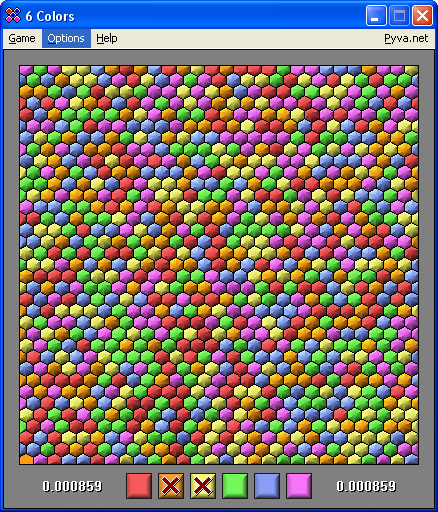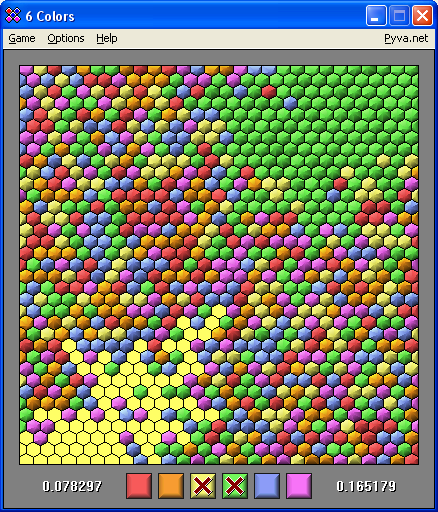Retro Replay Review
Gameplay
6 Colors delivers a deceptively simple premise that quickly evolves into a deep strategic challenge. Each turn you choose one of six colors, annexing all adjacent tiles of that hue into your domain. This mechanic rewards foresight: you must balance expanding your territory with blocking your opponent’s moves, all while avoiding selecting the color they just played. The restriction keeps matches dynamic, as you can’t immediately undo your rival’s progress but can plan several moves ahead to counteract their strategy.
(HEY YOU!! We hope you enjoy! We try not to run ads. So basically, this is a very expensive hobby running this site. Please consider joining us for updates, forums, and more. Network w/ us to make some cash or friends while retro gaming, and you can win some free retro games for posting. Okay, carry on 👍)
The inclusion of multiple tile arrangements—square, hexagonal, and randomized shapes—adds considerable variety to each game. Square grids offer familiar orthogonal tactics, while hexagonal layouts open up diagonal flanking opportunities. The random-shape boards provide unpredictable contours that force you to adapt on the fly, preventing any single strategy from dominating. Flipping the board for a second run ensures both players experience the same starting conditions, lending a sense of fairness to competitive play.
Whether you face off against a human opponent on the same PC or test your wits against the built-in AI, 6 Colors remains engaging. The AI scales reasonably well, presenting a tough but beatable challenge for newcomers and veterans alike. Matches are brisk—typically under ten minutes—making this an excellent pick-up-and-play title. A quick game quickly turns into a ladder of rematches, as each board shape and color distribution yields fresh tactical puzzles to solve.
Graphics
As a freeware homage to 7 Colours, 6 Colors adopts a clean, minimalist aesthetic that centers on clarity over flair. Each of the six hues stands out vividly against the neutral backdrop, ensuring that territory edges and potential moves are always easy to spot. There are no distracting animations or special effects; instead, the focus remains squarely on the board and the shifting pools of color that represent each player’s domain.
Tile shapes are rendered crisply, with thin borders delineating individual cells and highlighting the organic structures formed by random-shape boards. The UI is unobtrusive: a sidebar displays turn order and available colors, while simple icons convey game options. Menus are functional rather than fancy, but they load instantly and allow you to jump into a new match with minimal fuss.
While hardcore graphics enthusiasts may find the visuals austere, the stripped-down presentation fits the game’s cerebral design. By foregoing elaborate effects, 6 Colors keeps your attention on planning moves and outmaneuvering your opponent. For fans of abstract puzzle games, the interface strikes a fine balance between utility and aesthetics.
Story
6 Colors eschews a traditional narrative, embracing its abstract roots entirely. There is no cast of characters or unfolding plotline—just two rival “armies” of color vying for dominance across a tessellated battlefield. This bare-bones approach might deter players who crave story-driven campaigns, but it also frees the game from superfluous lore, placing pure strategic contest front and center.
That said, the lack of narrative can spark your imagination. Each match becomes a micro-tale of conquest, tension, and sudden reversals as territories shift hues with each move. You might envision the colors as elemental forces or rival kingdoms, crafting your own mental backdrop to the action. In this sense, the story emerges organically through gameplay rather than prewritten text.
Eventually, you may find yourself more invested in the ebb and flow of each board than in any external storyline. Victory feels earned, not because of an overarching plot milestone, but because you out-thought an opponent in a contest of pure logic. For players who view games as puzzles rather than episodic adventures, this implicit narrative is often more compelling than any scripted tale.
Overall Experience
6 Colors stands out as a tight, accessible strategy game that punches well above its weight. The learning curve is gentle—selecting colors and annexing tiles is easy to grasp—yet mastering the interplay of board shapes, color restrictions, and opponent psychology takes time. Quick match times make it ideal for short play sessions, while the lure of perfecting your opening moves and thwarting clever AI routines keeps you coming back.
Being freeware, 6 Colors offers tremendous value. There are no ads, no pay-to-win elements, and no DLC required to unlock new features. You get the full array of board shapes, single-player and hotseat multiplayer modes, and an endlessly replayable formula for zero dollars. For anyone seeking a lightweight yet deep puzzle-strat game, it’s hard to beat.
In summary, 6 Colors delivers a satisfying blend of strategic depth, visual clarity, and high replayability—all wrapped in a minimalist package. While it lacks a traditional storyline and polished presentation, its core gameplay loop is compelling enough to eclipse those shortcomings. If you enjoy abstract territory-control puzzles and want a free, portable challenge you can revisit anytime, 6 Colors is an excellent choice.
 Retro Replay Retro Replay gaming reviews, news, emulation, geek stuff and more!
Retro Replay Retro Replay gaming reviews, news, emulation, geek stuff and more!









Reviews
There are no reviews yet.